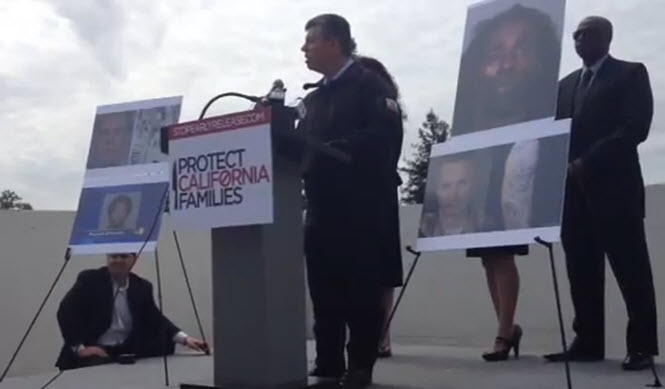
In the early 1990s, despite years of decline in the actual crime rate, politicians took advantage of public angst and frustration with high profile crimes, gangs and the crack wars, to push through a series of very harsh penalties. Over the course of the next two decades, the crime rates continued their drop from their late 1970s peak, as prisons filled up.
Realignment was the result of a federal court order for California to reduce its prison population. It shifted prison populations from the state to counties. While many accused realignment of simply shifting the problem, there was a strategic nature to that shift. County prosecutors make the charging decisions and the hope was that by making counties responsible for their own prison population, it would change the way criminal charging occurred.
Last week, former State Senator and Lt. Governor Abel Maldonado announced he was planning to file a ballot initiation repealing realignment – an issue that some believe is a potential liability for Governor Jerry Brown.
Abel Maldonado was appointed to the Lt. Governor position but could not beat out Gavin Newsom to be elected in his own right, and he failed in his challenge against Representative Lois Capps for her Congressional seat.
As Sacramento Bee columnist Dan Morain notes, “His chance of defeating Gov. Jerry Brown is roughly zero, give or take a decimal point.”
However, he notes that Republicans are searching for an issue that might have traction, and so they are pushing for an initiative to force the death penalty to be used again and to repeal realignment policies that shift low-level felons to county jails.
The problem for Mr. Maldonado is that Jerry Brown has been deft at handling the issue, while he has been clumsy.
In a move likely to anger many of his own supporters, Mr. Morain reports that “Brown, a moral opponent of the death penalty, took time last week to meet with San Bernardino County District Attorney Michael A. Ramos, one of the prosecutors fighting California’s death penalty moratorium, now in its seventh year.”
The meeting hit paydirt as Mr. Ramos was sold sending a message: “After a respectful discussion about our philosophical differences regarding the death penalty, we discussed what the law is and how the people voted for capital punishment. He understands the vote of our citizens.”
Mr. Morain writes, “Ramos wrote that despite Brown’s opposition to capital punishment, the governor told him he is moving forward with the ‘single drug protocol’ for lethal injections, a step that could speed executions by replacing the current three-drug concoction that federal courts have blocked.”
Mr. Ramos told Dan Morain, “A lot of people in my world weren’t sure where the governor was on the single-drug protocol… At this time – unless something strange happens – as far as this DA is concerned, I consider him a partner of mine in fighting for justice.”
Meanwhile, Abel Maldonado has stumbled out of the box. Dan Morain reports not only is he showing up at cities without announcement, but he made the mistake of trudging out “a photo of a black man with the words ‘Repeat Offender.’ “
As Mr. Morain notes, “Maldonado, a decent guy, is no racist.” But he fumbled the optics.
Nevertheless, Mr. Morain adds, “But the vehemence of the Democrats’ attack underscored their concern that Brown and Democratic legislators could be in jeopardy on the issue of crime.”
The Democratic fear is this: “Brown’s realignment, a reaction to a federal court order that he cut prison population, has reduced the number of prison inmates to below 120,000, from a high of more than 170,000 when Arnold Schwarzenegger was governor. Any one of them could commit a terrible act.”
Democrats remember getting hammered on Willie Horton. The Democrats remember getting hammered on crime in the early 1990s. They are willing to make reforms, but they seem very skittish.
The facts of the case do not really matter if it can be used to scare voters.
For example, Mr. Maldonado highlighted the figure of 57-year-old Jerome Rogers, accused of murdering a 76-year-old San Bernardino woman.
Mr. Maldonado pointed to Mr. Rogers’ history that involved “sodomizing a 14-year-old girl.”
However, the LA Times reports, “Rogers’ alleged crime appeared to have little or no connection with realignment. California corrections officials said he was released from state prison in 2000 and finished parole in 2003, eight years before Brown’s policy change took effect.
“San Bernardino County corrections officials confirmed that Rogers, who has pleaded not guilty to murder in the woman’s slaying, had no other criminal record in San Bernardino until December 2012, when he was sentenced to, and served, 13 days in jail for failing to register his address as a transient sex offender. That time behind bars occurred one month after the slaying.”
These facts did not stop Mr. Maldonado’s adviser from telling the Times that Mr. Rogers’ case was touted because “he is a prime example” of the public safety threat created by prison realignment.
“It’s people like him who are being released,” said the advisor, Jeffrey Corless.
The paper stated, “He could not specify, however, what about Rogers would put him in that category.”
Democrats are starting to stumble over themselves to introduce legislation to amend realignment before they get outmaneuvered.
For example, there is AB 222, sponsored by Democratic Assemblymember Ken Cooley from Rancho Cordova.
Assembly Bill 222, supported by Sacramento County District Attorney Jan Scully and Sacramento County Sheriff Scott Jones, would ensure that convicted offenders who sell or transport more than one kilogram of heroin, cocaine or methamphetamine will serve their incarceration in state prison and not county jails.
“This legislation goes far to ensure drug traffickers face the consequences of their crimes in state prison,” said Assemblyman Ken Cooley. “Selling more than a kilo of cocaine should not give a dealer a ticket to county jail. These are hardened criminals and they belong in a state prison with the capability to house and rehabilitate our most serious offenders.”
Then there’s AB 601, sponsored by Stockton Democratic Assemblywoman Susan Eggman and co-authored by Assemblymember Cooley, which would give judges the discretion on whether to send repeat parole offenders back to prison rather than county jail.
“Our bill does not require a blanket return of all parole violators,” said Assemblywoman Eggman. “It simply restores the option.”
She added, “Reducing the prison population could be achieved by releasing nonviolent offenders and those doing drug and alcohol rehabilitation, instead of repeat parole violators.”
“They did say you must get the population down,” Jeffrey Callison, a spokesman for the Department of Corrections and Rehabilitation, had said. “The deadline is the end of this year. Twenty-one days to produce a plan. That’s May 2. And if the plan isn’t produced, the court did threaten contempt of court against the governor and other top officials.”
Many Democrats are skeptical of the plan, noting its cost and the fact that many of the violations are not actually new crimes, but rather technical violations.
That bill ultimately stalled.
In his May revise, the governor plans to give local probation departments a small boost in funding for programs that would prevent offenders from returning to state prision.
It would also create a program in which offenders sentenced to long-term jail commitments could be exchanged for prison inmates.
This is similar to some Republican proposals, but the adjustments to realignment are very modest when compared to the 13-bill package that legislative Republicans proposed this spring to reform realignment. Those bills have been blocked in committees controlled by the Legislature’s Democratic majorities, but many of the GOP proposals may return for consideration in 2014.
“Is realignment a perfect surgery? No,” Brown said.
Our biggest concern is that politics and not public policy will win out here. For all of the fears of realignment, it is important to remember that it is a program that will transfer people to county custody – people who have not been convicted of serious crimes and people who will be released in a relatively short order anyway.
The reality is that we need policies in place that deal with recidivism and end the decades-long prison industrial complex.
—David M. Greenwald reporting





the old way was too expensive, created a very high recidivism rate, yet some people want to go back to the bad old days?
[quote]County prosecutors make the charging decisions and the hope was that by making counties responsible for their own prison population, it would change the way criminal charging occurred.[/quote]
Who’s hope was that?